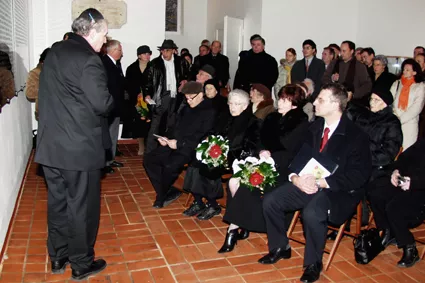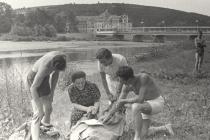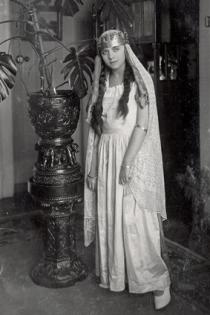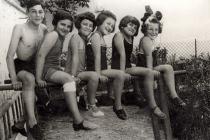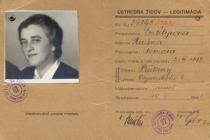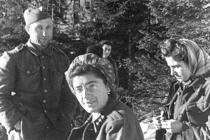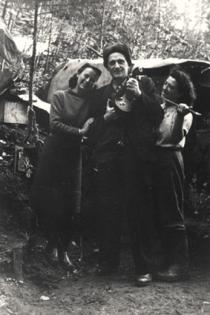Unveiling of the memorial to victims of the Holocaust in Piestany
This photograph was taken in 2006 at the Jewish cemetery in Piestany, on the occasion of the unveiling of the memorial to survivors of the Holocaust. I’m sitting in the first row, third from the right.
The idea of the memorial came about long before that. Sometime around the 1970s they approached me, that they wanted to write about some forgotten architects. I met with Mr. Mrna, who was looking for information on Mr. Weiss. Mr. Weiss was a contemporary of my parents’. By coincidence we had his photograph. He had a list of Jews who’d been deported and hadn’t returned. I looked at it and told him that there was a huge number of people missing. The town should build them a memorial. Piestany, Trnava, Topolcany. Those were Guardist bastions. I couldn’t stop thinking about it, and so I wrote my relatives in Israel, and they sent me a list of Piestany Jews that hadn’t returned. That list was put together right in 1945 at the initiative of Mr. Grünwald from Vrbova.
We didn’t want to write on the memorial that a thousand Jews had perished. We wanted to return those people their identities. Later they held it against us, that it could have come out a lot cheaper. We wanted to do it properly. At that time we started down the hard road of looking for the first names of children and adults that had been deported. Getting access to the birth records of the town of Piestany was a huge problem, because the permission of the mayor was necessary. I complained to a children’s doctor, Dr. Sajmovic, that we weren’t able to make contact with Cicutto [Cicutto, Remo: current mayor of Piestany]. Dr. Sajmovic told me: ‘That’s no problem, I treated him when he was a boy.’ Finally the mayor gave me permission. I couldn’t just look into the birth records, where the birth certificates were. One civil servant helped me immensely in this. I was writing out Jewish names and dates of birth. She would then look for the birth certificate in another file. In this manner we searched out entire families.
The biggest problem was to get into the State Archive in Bratislava. They’re big anti-Semites there. Again Dr. Sajmovic helped me; he belongs to the Hidden Child group. Once during a get-together in Bratislava a lady appeared who spoke very good Slovak. She was an American who’d married a Slovak and had come here to visit. I met with her, and she gave me the name of a woman who worked for the state archive. I called her and got into the state archive. They told me that I had to announce myself two days in advance. So I announced myself.
They’re large archives, and they contain lists of the names of people that had been deported. They brought me the list of individual transports, and one they forgot. They forgot to bring me the list of names of the transport of Piestany girls. There were 200 of them. I undertook that we’d write former residents of Piestany for a contribution. The Slovak Union of Jewish Religious Communities also contributed 250,000 crowns. A friend put an ad into the Hebrew-Slovak newspaper in Israel. Many answered it. We communicated in English and German, but many of them still spoke broken Slovak.
Mr. Mrna is incredibly meticulous. When we began, I told him that we didn’t have any money or connections. So I approached Dr. Samovic. He helped us a lot. Because he was a doctor and treated children as well as their parents, he had connections. With his help we gained a lot of generous sponsors. Mr. Sajmovic is still alive to this day, but is currently in Hungary. We built the memorial in the ceremonial chamber of the Piestany Jewish cemetery. The ceremonial chamber was in a state of neglect, but we had an expert, Mr. Mrna, an engineer, who said that after certain repairs it could be used. So the whole thing succeeded.
